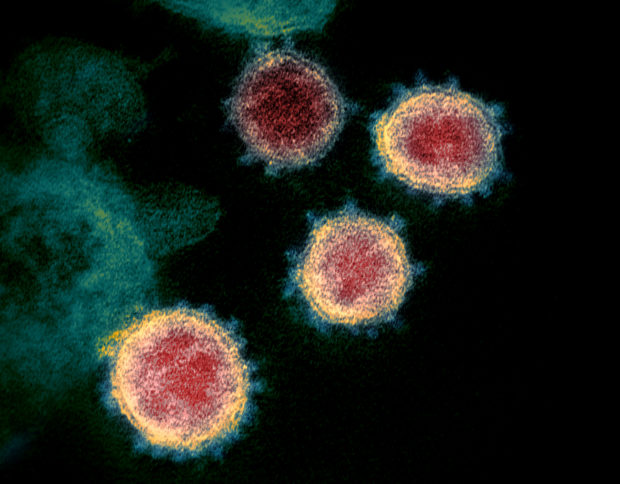
FILE PHOTO: This undated transmission electron microscope image shows SARS-CoV-2, also known as novel coronavirus, the virus that causes COVID-19, isolated from a patient in the U.S. NIAID-RML/Handout via REUTERS.
MANILA, Philippines — The reproduction number of COVID-19 cases in Metro Manila continues to grow, hitting 1.12 during the previous seven days, the OCTA Research said Friday.
In its report, the independent pandemic monitor noted that “the reproduction number in the NCR increased again to Rt = 1.21 for the period of July 16 to 22, from 0.92 the previous week.”
Reproduction number is the estimated number of cases stemming from a single case for a particular time.
According to OCTA, the average number of new daily cases in Metro Manila was 851 from July 16 to 22, which was 39 percent higher than the 613 average daily cases it logged the week prior.
However, the Department of Health (DOH) data showed that the capital region registered 797 average daily cases from July 16 to 22, a 28-percent increase from the 618 average daily cases from July 9 to 15.
READ: COVID-19 cases increase by 12% as more regions register rising infections
Professor Guido David, an OCTA Research fellow, explained to INQUIRER.net that their group and DOH differ in figures and calculations probably because the health agency was counting cases based on the date of symptoms onset.
OCTA then pointed out that the positivity rate, or the percentage of people who test positive among those tested, was still at six percent in Metro Manila as hospital bed utilization and ICU occupancy in the region was at 37 percent and 44 percent – both at low levels.
OCTA also said a more than 40-percent hike in new cases were recorded in the cities of Manila, Caloocan, and Valenzuela. However, only Makati City had a high average daily attack rate (ADAR) of 11.71 per 100,000 population from among local government units in the NCR.
The country has so far detected 47 individuals infected with the highly transmissible COVID-19 Delta variant. Seven of these were local cases documented in Metro Manila: four in the City of Manila, two in Pasig, and one in Taguig.
In Central Visayas, the cities of Cebu, Mandaue, and Lapu-Lapu had a “significant” increase in new COVID-19 cases, according to OCTA.
“These three LGUs also had ADAR greater than 10 per 100,000 and very high reproduction number. Hospital bed and ICU occupancy remained low in these LGUs,” it added.
In the Ilocos Region, Laoag is seeing a “major surge” with a high growth rate of 82 percent, a very high infection rate or reproduction number of 2.14, and a very high ADAR of 59.70 per 100,000, it further said.